2015
We Got Words for Everything

Ten Words You’ll Likely Never See Let Alone Use
- cachinnate – to laugh loudly
- coprolalomaniac – someone who compulsively uses foul language
- crurophilous – liking legs
- glabella – the space on your forehead between your eyebrows
- glossolalia – gibberish, especially from speaking in tongues
- hesternal – having to do with yesterday
- labrose – thick-lipped
- nazzard – a lowly or weak person
- onygophagist – a fingernail biter
- ribazuba – walrus ivory
Are all these words real words? I dunno. I could only find three of the ten at Dictionary.com. You could look them up in other sources. I didn’t bother. After all, as the title line suggests, I’ll likely never see or use them anyway. Listverse thinks they’re real, at any rate.
Which raises the question, what makes a word real or not? How widely or how often must it occur? Must it appear in print? Does the Internet qualify as being in print? Apart from playing Scrabble, does it matter?
Seems it would make a difference if you wanted to be read and understood. Though, that didn’t seem to matter to James Joyce. Have you ever tried to read Finnegan’s Wake? Talk about glossolalia. The book is loaded with neologisms, the literary term for fake words. A word from the book you’re familiar with, quark.
Physicist Murray Gell-Mann named the subatomic particle after a word he found in Finnegan’s Wake. Joyce’s line reads, “…three quarks for Muster Mark,” with “quark” referring to the cry of a seagull.
Filed 12/12/15
You Didn’t Ask, but We’re Telling Anyway

Fifteen years ago today in Suck dot com… OK, not today but fifteen years ago at any rate. Rather than refer to the article it went with, let’s have some new old somewhat related content from a 1999 Reader’s Digest article by Army vet Catherine Aspy.
“I was stunned. The Army was a vast day-care center, full of unmarried teen-age mothers using it as a welfare home. I took training seriously and really tried to keep up with the men. I found I couldn’t. It wasn’t even close. I had no idea the difference in physical ability was so huge. There were always crowds of women sitting out exercises or on crutches from training injuries.
“They [the Army] were so scared of sexual harassment that women weren’t allowed to go anywhere without another woman along. They called them ‘Battle Buddies.’ It was crazy. I was twenty-six years old but I couldn’t go to the bathroom by myself.”
Filed 12/6/15
Oil and Water Mixed Trivia
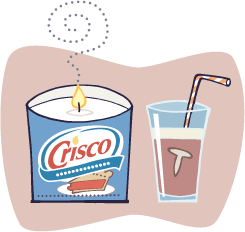
Modern extracted vegetable oils were first developed in the 19th century to replace whale oil, to make candles, and for other non-food uses. When the advent of petroleum and electricity put the kibosh on all that they repurposed them as food. These oils are liquid even when refrigerated so they hydrogenate them to make them solid at room temperature, which is how shortening is made. Crisco, woulda-been candles you eat. Yummy.
You might wonder what canola oil is. I mean, have you ever run a cross a canola plant? There is no such thing. Canola oil is made from rape seeds. Manufacturers figured folks wouldn’t buy rape oil. Sounds pretty unsavory for more than one reason. Since a lot of the rape plants are produced in Canada, they named it can(ada)ola oil.
Every living thing is mostly water. Think of how much smaller a raisin is than a grape. So, most everything you eat is loaded with water, unless you dehydrate it, like a raisin. Meat is also watery, sirloin steak is 71% water. Care for a swig of roast beef?
Every food containing fat contains all three types: saturated, monounsaturated, and polyunsaturated. There is more unsaturated fat than saturated fat in red meat, fish, nuts, and seeds. Dairy products have more saturated than unsaturated fat. The award for highest saturated fat goes to… coconut oil.
Filed 11/24/15
Laughter Is the Best Mnemonic Tonic
Click pic to replay animation
“An optimist is a person who doesn’t give a whoop what happens so long as it doesn’t happen to him.”
That Vaudeville one-liner from the act of Howard & McCane is a lot like an old bit by Mel Brooks along the lines of: Tragedy is when I cut my finger. Comedy is when you fall in an open manhole and die.
There can be truth in comedy, recognizing a common human foible in a joke is partly what makes it funny. The reverse is true as well, there is comedy in truth. Spotting the nonsensical in human behavior can also be funny. You know, good old observational humor. Which began... who knows?
The ancient Greek orators probably included jokes to make their points. I’m guessing. I really don’t know what passed for a joke in old Athens. Maybe they had “dumb Spartan” jokes. “How many Spartans does it take to change lamp oil? Two. One to hold the lamp and one to whip the Helot changing the oil.”
The thing about stating a truism with a joke is that funny is memorable. Humor is a mnemonic device, like rhyming is. It’s easier to remember a funny line or a poem than straight, dry prose. Combining the two renders a line you won’t forget. As for instance Ogden Nash’s: “Candy is dandy, but liquor is quicker.” Which was a reply to Dorothy Parker’s, “Men don’t make passes at girls who wear glasses.”
Not that the truth in a humorous aphorism is always so profound. Hey, jokes aren’t always funny, either. Then again, if it isn’t funny maybe it isn’t really a joke.
On the other hand, things that used to rhyme don’t rhyme now because word pronunciations change over time. That’s why a lot of Shakespeare seems to only sort-of rhyme. When he wrote it, it did. Which means some of the wordplay and puns in Shakespeare are lost on modern audiences. The Bard of Avon just isn’t as funny as he used to be.
Filed 11/23/15
Every Morning Students Recited the Pledge of Allegiance to the Hag
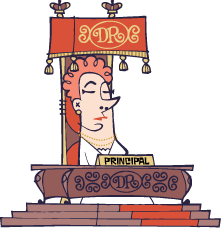
Once again, another Reason magazine “Brickbats” spot art rerun, another bit of what-the-heck-are-they-smoking.
Parents of students at California’s Calimesa Elementary School weren’t happy with a new policy that required students to kneel before Principal Dana Carter and a few other administrators. Officials described it as a safety measure.
Now then, class, what can we learn from educators? Anyone?
Filed 11/21/15
Infrequently Answered Questions
The Very First of a Gazillion Diet Books

Q: They say Edgar Allen Poe begat the detective story and Henry Fielding pioneered the novel, who started diet books?
A: The very first diet book was published in London in 1864, Letter on Corpulence, Addressed to the Public by William Banting. Though it was more a diary than a how-to guide like today’s diet books.
Mr. Banting was a rolly-polly little man, five feet four, two hundred pounds. On the advice of his doctor he drastically cut sugar and starches and successfully began to shed the pounds. He was so impressed with the results he wrote a diary describing all his meals and the weight he lost, forty-six pounds altogether. The diary became the book, a best-seller in its time. Avoiding sugar and starches as the best way to lose weight held sway for next one hundred years.
While the Atkins low-carb, high-fat diet is generally considered revolutionary (the book’s titled Dr. Atkins’ Diet Revolution after all) Dr. Atkins recommended essentially the same diet described by Banting. In South Africa today they don’t call low-carb, high-fat eating the Atkins diet, they call it Banting. Only they use it like a verb, to bant, the act of banting.
In an interesting twist, one of the two men who first isolated insulin, the hormone controlling fat storage, was Frederick Banting. No relation to William as far as I know.
One might wonder how we went from carbs being fattening to today’s conventional wisdom of fat being fattening. That’s a whole ‘nother story, one not as simple or clearcut as either the advocates or critics of low-fat would have you believe.
Filed 11/19/15
You Can Tell a Sly Fox by Its Covering

You can’t judge a book by its cover.
Beauty is only skin deep.
Russia began a captive arctic fox breeding program in the 1950s. They found these foxes had one of three basic behaviors around humans: aggression, avoidance, or calm and curious. The last being what you might call tame, or perhaps dog-like. So the Russians bred their captive foxes for tameness, it just made them easier to deal with.
Then the unexpected happened. While wild arctic foxes are all black, the bred-for-tameness foxes developed white patches. When these tamer foxes were cross-bred back with the wilder foxes the patches disappeared. In other words, even though the foxes were selected and bred for temperament, the appearance changed.
You can’t judge a book by its cover? Considering the Russians experience, maybe you can judge a fox by its cover.
Compare this to the experience of dog breeders. It is well known that different dog breeds have different temperaments. Many show dog breeds were selectively bred for appearance, not temperament. Yet with similar, if reverse-wise, results as with foxes: change the appearance and the temperament changes.
Beauty is skin deep? Considering the above, it may go deeper than that.
Gene expression is not so simple as geneticists first thought. Changing one bit of code changes some seemingly unrelated bit of code. Kinda like a Three Stooges bit, close one filing cabinet drawer and another pops open. Get it? The files hold information like DNA holds information…
Now that we’ve tortured those analogies and sayings to death, we have another old saw about leopards changing spots… Aw, skip it.
Filed 11/7/15
Hormones Can Make You Fat
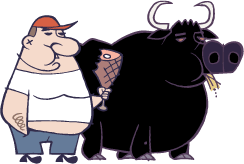
The beef cattle industry uses what’s called feed efficiency to control both costs and how cattle grow. When ranchers finish cattle, fatten them up for the slaughterhouse, they don’t just put down more feed and say “Eat, eat, you look like a scarecrow.” They give the cattle hormones, insulin, to stimulate fat production.
Feed efficiency grew out of Nobel-winning science from the 1960s when the technology was developed to map out the mechanism. Insulin moves calories into fat cells for storage and prevents calories coming out. Basically, high insulin means fat creation, low insulin means fat burning. Carbohydrates drive insulin, eating carbs and sugar raises insulin levels.
Normally a body cycles between fat storing and fat burning. It only burns fat when insulin levels are low, which is some hours after eating carbs. For people it’s mostly during sleep or fasting. As you might know, breakfast means break fast. So, to make cattle fat they keep insulin levels higher than usual so they stay in fat storing mode.
It’s complicated, but growing a fat cow is about hormones. Just like growing a big cow is about hormones, growth hormones. Every biologist agrees with all this. So far so good.
When people get fat all the science above is thrown out the window by the experts who instead say people get fat simply because they eat too much and don’t exercise. It’s not hormones or metabolism or anything like that, it’s gluttony and sloth which people were lured into it by junk food, fast food, TV, and video games made by greedy corporations.
Cows get fat because of hormones, people get fat because of the seven deadly sins. How very scientific.
Filed 11/3/15
To Don’t List

“You’ve got a Snippet in my Lists. No, you’ve got a List in my Snippets. It’s two, two Shorts in one.” Two dated pop culture references for one old Suck dot com pic. And now, the new content:
Ten Habits of Ineffective People
2. Poor organization
b. no atention too details<
3. Not finishing what
4. Inconsistency
Losing track of things
6. Duplication of effort
7. Duplication of effort
10. Getting ahead of yourself
8.
9. Skipping important steps
If that wasn’t worth the time it took to read, this bit of text underneath might be less so. Still, you went ahead and read it, didn’t you? One more thing to add to the list, poor time management. Now, stop surfing the web and get to work.
Filed 10/27/15
The Casual Sportsman
Final Score: Lewandowski 5, Wolfsburg 1



Click pic to play animation
The Casual Sportsman doesn’t follow the Bundesliga closely, actually not at all, but we did read lately how Bayern Munich striker Robert Lewandowski came off the bench and scored five goals in 10 minutes. Which is pretty astounding.
That’s a full game rate of 45 goals per game. Which is pretty ridiculous. Just shows how silly it is to extrapolate an unsustainable short trend to a long trend. If you included all of Lewandowski’s previous games and goals it would hardly budge his career goals per game average at all.
Still, people like to get carried away with that sort of thing. That’s how pyramid schemes promise to make everyone a millionaire. Which they never do.
Robert Lewandowski 5 Goals, 9 Minutes, 5 Records in Bayern vs Wolfsburg 5-1
Filed 9/27/15
Useless Diagrams and Equally Useless Rules of Grammar

Another old Suck dot com spot for which I’ll provided new content in reference to the picture. Which is the opposite way these things are usually done, but can’t be helped in this case because the picture was done years ago. What more is there to say about that?
I remember diagramming sentences when I was in junior high. I could never see the value in it. Still don’t. Seems to me you improve your writing skills, find the best ways to construct sentences and what-have-you, by reading and writing, examples and practice. How parsing sentences into these weird, tree-like structures was supposed to mean anything to a 12 year-old is a mystery to me. Besides, if you wrote an entire book in diagrammed sentences it’d be unreadable.
You do need structure in language, that’s what grammar is all about. All the same, there are some rules you learn that really don’t make sense. Or they’re just wrong and should be ignored. Like the don’t end a sentence with a preposition business which came from Latin grammar and doesn’t even apply to English.
Rather than duplicate my source’s effort, you can read all about it at Mental Floss:
Four Fake Grammar Rules You Don’t Need to Worry about
Did you find their headline awkward or confusing? It ended in a preposition. Following the rule you get, “Four Fake Grammar Rules about Which You Don’t Need to Worry.” Does that sound better to you? Maybe it would translated to Latin, but in English not so much.
Filed 9/25/15
Why Summer Has Dog Days

According to the temperature record July is the hottest month in these parts. According to my perception record
In any case, the hottest stretch is the dog days of summer, roughly July 3 to August 11 when Sirius is most prominent in the night sky. Sirius is part of the constellation Canis Major, Latin for “Greater Dog.” (Not to be confused with “the big dog” which I think is an expression from the American south.) Sirius is the dog of Orion, the hunter, and so the star is known as the Dog Star. Sirius is Greek for “searing or scorching.” Very early Greeks thought the Dog Star was partly why early summer was so hot.
In the end, the dog days have nothing to do with dogs laying around in the sun, or the heat making everyone dog tired, or anything to do with earthly dogs. It’s sort-of the Dog Star days of summer. They tell me only mad dogs and Englishmen go out in the noonday sun. If they did, they wouldn’t see Sirius which can only be seen at night. Still, there are no dog nights of summer. Go figure.
By the way, all this only applies if you live in the north. Right now it’s winter in Australia, Argentina and lands below the tropic of Capricorn. They might not even be able to see Sirius down there, though I couldn’t say for sure.
Filed 9/20/15
The Casual Sportsman
Baseball in the Land of the Midnight Sun
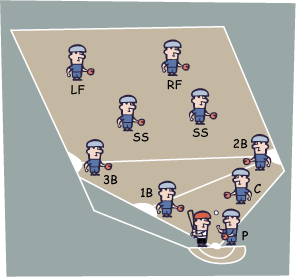
When we think of Finland and sports we naturally think of winter sports, hockey, skiing and the like. That is, if we ever think of Finland and sports. Doesn’t come up much. Anyway, they have summer in Finland and so they have summer sports, too. For instance, they play baseball. Though not really baseball you’d recognize, a Nordic version of baseball invented about a hundred years ago called pesäpallo.
Finnish baseball is played on a five-sided dirt field shaped like a big, elongated home plate. In American baseball fair territory goes on forever and over the fence is homerun territory. In pesäpallo everything outside the lines enclosing the field is foul territory and so all homers are inside-the-park jobs. Though the batter only needs to reach third to get one. Which we suppose makes it a thirder and not a homer.
In pesäpallo the pitcher stands next to home plate (circular and not home plate shaped) and throws the ball up which the batter hits on the way down. Kind-of like two-man fungo. Since they don’t need a catcher behind the plate, he plays in front of the second baseman, who plays where American baseball first basemen play. There is no center fielder, instead there are two shortstops. Who play in the outfield.
Oddly, first base is to the left half way to third base. Second base is where first base should be and there’s no base at second. Third base is still third base though behind first base. (One imagines a new Abbot and Costello routine. “Who’s on first? Where is second? What happened to third?”) From third runners take a bent path in foul territory to a second home plate, which isn’t a plate but a big semi-circle where the entire team at bat lines up on deck.
Finns go for the designated hitter in a big way. They have three of them, which they call jokers. Being at the arctic circle, Finnish night games can be played without lights. Players wear helmets at all times. Though with the way they pitch, straight up and down, we wonder why. Granted, we don’t speak Finnish, but if you drop the umlaut and replace the Ps with Bs you get besaballo. Cue Garrett Morris, “Besaballo been bery, bery good to me.” Feel free to groan softly.
More about Finnish baseball at Pesapallo.net or this article from The Wall Street Journal. Watch a You-Tube video on the History of Pesäpallo. We say watch because it’s in Finnish. What can we say? Pesäpallo doesn’t have a big English speaking following.
Filed 7/24/15
Infrequently Answered Questions
As a Living Document, It Needs Doctoring

Q: Why does the Supreme Court decide what a recently passed law means? The people who wrote and passed the law are still around, why don’t the authors get to say what it means?
A: That’s just the American constitutional process. Which the framers didn’t know about until the very first Supreme Court divined it hidden in the Constitution. This is called a ruling by divined right. Only judges, or better yet justices, can decipher the true meanings because they’re encrypted in what they call the legal code.
The court not only says what the Constitution and laws mean, they also define the words used. And so fine means tax and state really means national government. As a result, lawmakers don’t know the meaning of the laws they’re writing or passing until the Supreme Court tells them afterward. This explains why Congress must pass a law in order to find out what’s in it. These are laws of unintended consequences.
You can think of Supreme Court justices as sort-of law seers. They wear black robes, sprinkle their speech with Latin, and meet in special justice chambers to communicate with the spirit of the law. All this helps them reach a decision, which often require a lot of language stretching because some decisions are quite a reach.
Filed 7/23/15
America Celebrates











Click pic to play animation
It’s July fourth and so it’s The Fourth of July. Independence Day, the anniversary of the signing of the Declaration of Independence. The document that once and for all established the right of a people to break political bonds and rule themselves.
“Once and for all” meaning eighty years as Americans then fought another war to “preserve the union.” So, if you win the war you have the right to independence; if you lose, you don’t. Thus establishing the true ruling principle: might makes right.
These wars are called the American Revolution and the American Civil War. If we called both wars of independence it’d be obvious Americans were both for and against independence, depending. This follows the principle that history is written by the winners. To coin a paraphrase, might makes write makes right.
Filed 7/4/15
Fat is Not Giving Europe a Heart Attack

The health and nutrition experts tell us eating fat will give you a heart attack. So, let’s look at the data from the largest test of this hypothesis ever, the eating habits of the entire population of Europe. The following is from the World Health Organization’s European Heart Study of 2008.
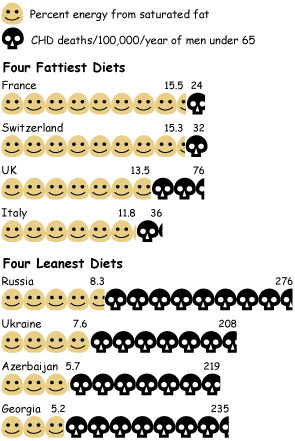
Notice anything odd? France has the fattiest diet and the lowest coronary heart disease (CHD) death rate. Georgia has the leanest diet and the second highest CHD death rate. The French eat almost twice the fat as Russians and have less than one tenth the CHD death rate. The overall trend shows the more fat the lower the CHD death rate.
Yet somehow a low fat diet is “heart smart.” Why do they say this? I don’t know, but medical experts can believe two totally contrary things at the same time. Maybe they think the sample size, all of Europe, was too small.
After a recent study by the British Heart Foundation the investigators concluded there was no evidence that saturated fat is bad for your heart. At the same time they claimed saturated fat raised cholesterol levels which is bad for your heart. Meaning saturated fat does and doesn’t cause heart disease. It’s not saturated fat, it’s Schrödinger’s fat.
Not all the experts are buying it. To quote Dr. George Mann, former head of the Framingham Study (where the fat causes heart disease hypothesis originated back in the 1950s): “The diet-heart idea (the notion that saturated fats and cholesterol cause heart disease) is the greatest scientific deception of our times… The public is being deceived by the greatest health scam of the century.”
The Cholesterol Hypothesis Is Wrong
Filed 6/30/15
Nothing Works Like Not Working

We could avoid the current brouhaha over increasing the minimum wage by taking a page out of the current farm policy playbook. That is, simply pay people for not working. We offer the Labor Price Support Act of 2015.
This will have a double effect on raising wages. It will reduce the labor supply thus driving up wages as employers compete for fewer available workers. Also, a high non-working wage will force greedy employers to offer much higher working wages to entice workers away from a life of liesure to take a job.
Capitalist apologists may argue this will drive up the prices of labor-intensive goods and services. Not so. Employers currently squeaking by on thin margins will be happy to operate at a loss. Investors are already buying negative-yielding bonds, so why not negative-yielding businesses? Since IPOs of money-losing companies are all the rage, unprofitable businesses won’t be problems, they’ll be golden opportunities for Wall Street to drive up the stock market and supercharge the wealth effect. Boom times here we come.
Besides, if too many businesses go under the government can always start paying them for not producing any goods or services under the Business Support Act of 2016. There is no unproductive activity the government can’t pay for to make the economy work like a well-oiled Keynesian juggernaut.
Now, if you don’t think producing less makes us richer, you’re no economist who will tell you natural disasters and war are good for the economy. That’s right, destroying things make you rich. It’s a wonder Beirut isn’t the richest city on Earth.
Filed 6/28/15
Infrequently Answered Questions
Sodium Is Dangerous, Salt Not so Much

Q: What’s with low sodium foods and diets? Sodium is an alkali metal that reacts exothermically with water. Meaning it explodes. Are sadistic food conglomerates or terrorists lacing the food supply with sodium or something?
A: They don’t really mean sodium, of course, they mean sodium chloride, NaCl, salt. Don’t know why they omit the chloride part. Is it because the chlorine part makes no difference? Though very few have studied it, what evidence there is shows low blood chlorine (serum chloride) is a bad thing, being associated with higher mortality risk.
So, low sodium is supposed to be good and low chlorine is shown to be bad. Yet you don’t get the two separately as they come together as salt. Meaning, if you have low sodium, good, you have have low chlorine, bad. How does that work?
According to numerous studies, it doesn’t work. To quote one recent Australian study, “In a multivariate-adjusted model, those who consumed less than 3000 mg of sodium per day had a 25% increased risk of all-cause mortality and cardiovascular events compared with those who consumed between 4000 mg and 5990 mg/day (reference group).” In plain English, a low salt diet increased the risk of heart attacks and death. In Newspeak, low salt bad.
Here, too, they speak of sodium as if test subjects were somehow getting it minus the chlorine. Weird. Maybe it sounds more sciency and convincing to say sodium instead of salt.
Anyway, consider the following: Very ill hospital patients who cannot eat or drink are given an IV drip to replace fluids. That’s a saline solution of about 0.9% salt. A commonly administered dose of two liters a day delivers 18 grams of salt into the bloodstream – which has no effect on blood pressure by the way.
Yet dietary experts tell people to limit themselves to six grams of salt a day. Unless you’re in a sickbed when other medical experts pump 18 grams a day into you to keep you alive and well. Modern medicine works in mysterious ways.
Hat tip to Dr. Malcolm Kendrick’s blog. To confess, I basically took much of what he wrote and rewrote it my way. So, not so much a hat tip as a lift notice.
Filed 6/23/15
Cashless: No Cents or Sense

Top Ten Reasons the Ivory Tower Elite Advocate the Cashless Society
- To end the black market in used goods, you know, garage sales.
- They’re sick and tired of co-professors borrowing ten bucks for lunch and forgetting to pay it back.
- So there’s no way to pull your money out of the banking system and store it where they can’t charge you negative interest which they also think is a good idea.
- To make cash only express lanes slower.
- So during the next major power outage no-one can price gouge because all commerce will be impossible.
- So no-one can live independently off the
matrixgrid. - Because cash, anonymity and liberty are barbarous relics of the unenlightened past.
- There just aren’t enough surveillance drones to go around.
- Just one more in a long line of college pranks. They’re still laughing about that ‘whole language’ one.
- They’re insane.
What do you call someone with more eduction than common sense? Professor.
Filed 6/19/15
The Casual Sportsman
Rag Arms Are as Dead as the Dead Ball

Because baseball is managed so differently today than 100 years ago, there are many pitching records that will likely never be approached let alone broken. These have to do with decisions, innings pitched, and complete games. What with deeper rotations, middle relievers and closers, starting pitchers just don’t get the chance to ever approach, let alone break, those kinds of records.
I mean, if a pitcher won 20 games a year for 20 years they’d have 400 wins. Cy Young won 511 games, lost 316, pitched 7,335 innings and completed 749 games. All records. Now-a-days with a four man rotation your ace will get 41 starts. Jack Chesbro won 41 games in 1904. He also started 51 and completed 48 in a 154 game season instead of the current 162. These records were all set were during the dead ball era which might have something to do with it. Still, nobody has won 30 games in a season since Denny McLain in 1968, almost 50 years ago.
All the same there is one modern era (since 1920) pitching record that will likely never be broken. Cincinnati Red pitcher Johnny Vander Meer threw consecutive no-hitters against Boston and Brooklyn in 1938. Why this feat will probably never be topped is simple, to do so a pitcher would have to throw three consecutive no-hitters.
Trivia bonus: Vander Meer’s no-hitter against the Dodgers was the first night game ever played at Brooklyn’s Ebbets Field. Houston Colt 45s (Astros) Ken Johnson is the only pitcher to lose a complete game no-hitter, 0-1 against, coincidentally, the Cincinnati Reds in 1964.
Filed 6/17/15
Time Travelling Twin and Other Modern Science Silliness








The time travelling twin paradox. Heard of it? It’s the whole Relativity Theory business where a twin travelling in a spaceship at the speed of light leaves and returns to the Earth and is then younger than his Earthbound twin because time is supposed to slow down as you near the speed of light.
Yet according to Relativity there are no absolute reference frames and it is equally valid to say the Earth travelled away and returned to the spaceship at the speed of light. In which case the Earthbound twin will be younger. So either twin is younger than the other depending on which twin was referenced as moving.
Here’s another problem, speed is distance over time. Slowing time would increase speed. Say you travel a light-year, which at the speed of light slows time to, say, half a year. In which case you cover a light-year in six months meaning you’re travelling twice the speed of light, which slows time down so you go even faster, which slows time… where does it end? Do you suspect the time travelling twin paradox is just plain silly?
Modern physics is rife with silly things. Like a zero point singularity of infinite mass, temperature, and density. A point is a mathematical entity of zero height, zero width, and zero length. 0x0x0=0, in other words nothing and no space at all. Temperature is a measure of motion. How do you get infinite temperature when there is no space in which anything can move let alone exist?
As far as I can figure physicists simply assign a symbol or Greek letter to things which have no real physical meaning and stick them into formulas. Presto, the impossible becomes a mathematical fact. They call astrophysics the Queen of the Sciences. Tarted up with nonsense math and undetectable hypotheticals it’s now the Drag Queen of the Sciences.
“Today’s scientists have substituted mathematics for experiments, and they wander off through equation after equation, and eventually build a structure which has no relation to reality.” –Nikola Tesla
“Physics is mathematical not because we know so much about the physical world, but because we know so little.” –Bertrand Russell
“Science is the belief in the ignorance of the experts.” –Richard Feynman
“There is a theory which states that if ever anyone discovers exactly what the Universe is for and why it is here, it will instantly disappear and be replaced by something even more bizarre and inexplicable. There is another theory which states that this has already happened.” –Douglas Adams
Filed 6/14/15
The Casual Sportsman
Ty Cobb in the Baseball Hall of Frame

When asked about Jackie Robinson in 1952 this retired ballplayer told The Sporting News:
“The negro has the right to compete in sports and who’s to say they have not?”
Who said it? Perhaps the last person most would suspect, Tiger great Ty Cobb. A good deal of what folks “know” about the man, not the ballplayer, is twisted or an outright lie. From the New York Post:
How Ty Cobb Was Framed as a Racist
Which only goes to show baseless smears and libelous untruths can live on for decades. Heck, the fabricated equine perversion of Catherine the Great has lasted centuries. Once a thing like that sticks it’s hard to shake, facts be damned.
Sub-file under “people we love to hate” and cross-referenced to “don’t confuse me with the facts my mind is made up.”
Filed 6/2/15
You Can Hear a Lot by Listening

“They tell me his music is better than it sounds.”
–Mark Twain on Richard Wagner
While Twain’s bon mot sounds like a criticism of Wagner, perhaps it’s a comment on his fans, too. Seems to me the job of the modern art and music critic is to explain why something moronic and ugly is smart and beautiful in words that seem vague and esoteric but are in fact meaningless.
Then there’s the old “Beauty is in the eye of the beholder” gag. This is supposed to mean it’s all subjective. Yet I wonder if you could give a different interpretation. More like seeing is believing, or if it looks good it IS good. As Andy Warhol said…
“Pop Art is about liking things.”
Filed 5/29/15
When Hroses Wore Shews

Many, many years ago folks in England didn’t know about the birds and the bees. Only because the word bird used to be brid. Bee was bee, but wasp used to be waps. And a horse was a hros. Over time the sounds within the words got switched around. It’s a process called metathesis. How exactly does it happen? Don’t aks me. See, in some quarters it’s happening today with ask, aks.
Back in the day folks talked the talk and walked the walk differently. If you went back in a time machine and listened, you’d hear them pronounce the L in folk, talk and walk. Dropping a sound out of a word is velarisation. Anyway, you’ve got to figure they spelled the words with those now unsaid letters for a reason.
To show these things can be undone, Americans have returned the L sound to psalm and balm. If you listen to some folks talk they’re returning the T sound to often. Though nobody has started to say the T in listen or glisten. Yet.
Oh yes, the Y in ye was pronounced as the TH sound. That Y represents an old rune, thorn. Ye wasn’t said as yee, or thee, it was simply the.
Filed 5/5/15
Simple Water Molecule Is Simply Amazing

Living things are mostly water. By weight a person is about two-thirds water. On the other hand, the simple water molecule is much, much smaller than long-chained fat and proteine molecules. By count 99% of the molecules in your body are water.
We all know plants get energy from sunlight. Photosynthesis and all that. But, do people get energy directly from sunlight? Well, if Dr. Gerald Pollack is onto something about sunlight and what he calls the fourth phase of water maybe we do. Shine light on this structured water and it moves itself through a tube, it performs work, it has electrical charge separation. No chlorophyl involved, just H2O. Or in it’s fourth phase, H3O2.
So then, what is a living organism really all about? Is it all a sophisticated way of organizing the work done by water into a higher order function? Is life really carbon based as they say, or water based? Is water alive? Or proto-living, if that’s a real thing?
Filed 4/24/15
Fun With Flags

People like flags. What exactly the appeal is I couldn’t say, but you can’t deny people like flying them, wearing them, and sticking them on things. All the same, in my view there are only a handful of national flags that are both visually appealing and distinctive.
Way too many flags are hard to tell apart. Europe is full of non-distinctive striped flags. I mean, if you can’t tell what it is in a black and white picture it’s not all that distinctive. The best European flag is the UK union jack, both visually appealing and distinctive. I’d go so far as to say it’s the best national flag in the world. Though the union jack is really three flags in one.
The Japanese flag is very good distinctive-wise, though perhaps a bit sparse. China’s is OK, but how could they pass up having a dragon? The US flag is distinctive, but too busy with all those stars and stripes. With the blue panel in the upper corner it looks like a flag within a flag. Overall rather lopsided and ungainly. Plus it just looks wrong facing right-to-left.
Let me offer a new design for the US flag. To be less busy we lose the red stripes. Or are they white stripes? Whatever, ax the stripes. Fifty stars is a lot of stars. I get that they represent the fifty states, but states don’t mean much as now-a-days the feds run everything.
So we’re left with one white star on a blue field. Not that great. Besides, blue is not very inclusive, think of all the colors left out. Can’t have that. Let’s go with black and white. White covers the entire light spectrum, black makes all that color diversity pop. This leaves us with a white star on a black field.
Five-pointed stars on flags are a dime a dozen, plus too many communist countries use them. So let’s swap out the star for something else. Since it’s supposed to be a democracy we need something to represent people, like a human head. But it has to be generic, no ethnicity or sex. The flag should also have something to remind all foreigners that the US of A is the most powerful country on the planet. I think I’ve got it.


Mouseover to see the new, improved US flag
Now, that’s a flag!
Filed 3/31/15
Living In an Ice Age Ain’t All That Bad

The moon is about as far from the sun as the Earth and gets the same intensity of sunlight energy. Yet, the moon is some 50 degrees colder on average. It’s like the moon is in a permanent ice age. Except, it gets hotter in the sunlight than the Earth does. The reason, the moon has no atmosphere.
Here’s how it works, more or less. The sunlight side heats up, as it rotates into shadow it cools by radiating heat into space. Because there’s no atmosphere the heat doesn’t move around very much. After all, the hard surface of the moon doesn’t flow from place to place carrying heat with it, does it?
A fluid on the surface can move heat to the side in shadow by convection and conduction. Earth has two giant fluids covering the unmoving solid surface, the oceans and the air. So, heat moves from the sunlit side to the shadow side keeping the sunlit side cooler and the shadow side warmer.
The Earth also loses heat at night by radiating it into space. But the two giant fluids delay the suface heat escaping and so the average temperature remains higher than the moon’s. This is not due to any greenhouse effect, but because of the nature of the fluids. It would happen even if the atmosphere were entirely inert nitrogen.
The term “ice age” sounds like it would be winter everywhere all the time. OK, maybe when you first hear it as a kid. If the sun delivers the same energy, if the rate of heat loss (mostly at night) increases you get an ice age. There’s less melt-off, glaciers and snowpacks grow very large and remain all year.
The problem in living during an ice age is not so much the temperature, it still gets warm, it’s all that snow and ice in the way. Life beyond the icebound areas would be pretty much as it is today. If you lived in, say, the Bahamas, you mightn’t notice much difference. After all, winter in the Bahamas is pretty warm.
Filed 3/4/15
Romeo and Juliet, or Fools in Love
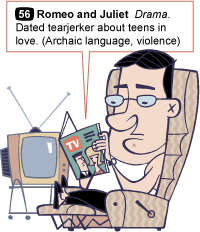
Were Romeo and Juliet victims of cruel fate, or maybe something else? Greek dramatists would say character is destiny. Shakespeare had it…
“The fault lies not in our stars, but in ourselves.”
In Act I Romeo first appears mooning over… Diana. Who? She never appears, yet Romeo is ga-ga over her. Until our hero crashes a masquerade party, meets Juliet and, bingo-bango, he’s in love. Again. Last we hear of what’s-her-name, Romeo drops her like yesterday’s news. Shows you what kind of a guy he is.
So he hangs around Juliet’s courtyard peering in her window. Rather stalker-ish, actually. After a bit of sneaky hooking up the pair run off and get secretly married. What was the long-term plan there, having secret children and living in a secret house or what? Teenagers, sheesh.
Then Romeo butts into a fight between Tybalt and Mercutio, in so doing his cousin is accidentally run through and dies. So Romeo runs down Tybalt and kills him, not accidentally. The guy is never at a loss for rash acts. Now he’s a wanted fugitive. And who’s to blame? Oh yeah, Romeo.
Now, Juliet isn’t faultless as she undertakes a half-baked plot of her own: faking her own death. You’d think you’d make darn sure your co-conspirator would know the plan before proceeding, but no, not Juliet. Anyway, Romeo finds her “dead,” isn’t wise to the scam, and kills himself. Impetuous and clueless to the end, this Romeo fellow. Then Juliet awakens from her “death,” sees Romeo has gone to meet his maker and offs herself with a dagger.
Whenever the shite hits the fan we find Romeo and Juliet at center stage, literally and figuratively. Who killed them in the end? They did it themselves. A pair of adolescent nitwits if you ask me.
One might say if not for the feud it all would have been hunky-dorie. Well, if a window were four feet up instead of forty you could jump out safely. But knowing it’s forty feet, do you jump out, break your neck, and then blame the window? Which brings us to something Shakespeare didn’t write…
Look before you leap.
Filed 2/27/15
Bad Grammar On Display All Over America

There’s an example of bad grammer you often run across that nobody seems to notice very much, if at all. Okay, maybe English teachers, writers, librarians and such notice, but they’re a buch of fusspots about grammar. Now that I’m mentioning it, I guess I’m a fusspot, too. Anyway, this common grammatical error is the sign at the market reading, “Express Checkout – Ten Items or Less.”
The basic rule: if you can count it in numbers use fewer; if it’s an uncountable quantity use less. The small bushel has fewer apples in it. Check. The small cup has less water in it. Check.
Using fewer in the wrong spot is obvious. You certainly wouldn’t say, “The small cup has fewer water in it.” That’s just wrong. Yet using less the wrong way doesn’t instantly send up a red flag, “The small bushel has less apples in it.” Wrong, but not obviously so as many people say things like that.
Then again, sometimes the rule doesn’t work. How about, “Used CDs – $5.00 or Less”? Here we have numbers of dollars, yet “Used CDs – $5.00 or Fewer” sounds flat out stupid. There must be some rule that explains it, but I don’t know what it is.
On the other hand, for a larger amount we use more in both cases. The small bushel has more apples in it. The small cup has more water in it. Check and check.
Back to the sign. Because items can be counted, up to ten as the sign suggests, it should read, “Express Checkout – Ten Items or Fewer.” Still, we’re used to the sign with less and not fewer so it doesn’t bother us. Besides, products all over the store play fast and loose with grammar and spelling, so I suppose by the time you get to the checkout you’re numbed to dubious language usage. E-Z Open Krispy Kreme Donutz Lite, anyone?
Filed 2/23/15
Spinflation: Cheaper Though It Costs More

Say there are only two car types in the whole world, Deluxmobiles and Econoboxes. Deluxmobiles have the latest and greatest of everything car-wise and sell for $50,000. Econoboxes are basic transportation selling for $20,000. A car costs $35,000 on average.
Then Econoboxes are upgraded to be the equal of Deluxmobiles. With improved manufacturing methods the improved Econobox sells for $40,000. Meantime, Deluxmobiles get even more deluxe and sell for $70,000. Cars now cost $55,000 on average.
Has the price of cars gone up? That seems a no-brainer: which is bigger, $35k or $55k? How can you argue with that? Well, people can and do. What they’ll say is “You’re comparing apples to oranges. The new Econobox is the equivalent of the old Deluxmobile. Comparing like to like the price has actually gone down $10,000.”
This is small consolation to the person buying the cheapest car possible for transportation. Comparing like to like, the cheapest available car, the price has doubled. Despite the hedonic adjustment of costing $10,000 less, this buyer must pony up $20,000 more.
Yes, the car is better. How better? Does the new, improved, twice-as-expensive Econobox get you to work twice as fast? Does it get twice the gas mileage? Does it carry twice as many passengers? Provide twice the protection from the elements? Cost half as much to operate and maintain? Is it twice as easy to drive? What does twice the price actually get you?
We’re up against the law of diminishing returns. That’s where it gets harder and more costly to increase performance after you’ve picked the low-hanging fruit. For instance, an Econobox is a vast improvement over walking. By comparisson a Deluxmobile is not as big an improvement over an Econobox as an Econobox is over walking. In basic utility of getting from point A to point B the improved Econobox is improved, but it’s debatable by how much.
This sort of thing happens in other areas where some new and improved item replaces an older version, but the new and improved replacement costs more. So there you go: spinflation, cheaper and costs more at the same time.
Filed 2/21/15
The Casual Sportsman
The Most Watched Game of All Time
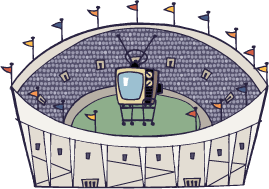
We at the Casual Sportsman are, well, casual about sports. But then we’ve said that before. Still, we are so casual we didn’t bother watching the Super Bowl as it pitted two teams we really didn’t care about. Even lacking the viewer eyeballs of the entire Casual Sportsman staff, Super Bowl XLIX still managed to be the most watched television event in American history with 114.4 million viewers.
Even so, it didn’t come anywhere close to the most watched TV event in the world. On July 20, 1969, 530 million people watched the Apollo 11 moon landing. Almost five times as many as the Super Bowl. Yet, that’s not the record either.
The largest TV audience ever was for a sporting event most Americans don’t care about. In fact, I’d venture to say don’t even know about. It’s not the FIFA World Cup, you know, soccer’s world series between nations. Can you even guess what sporting event the record holder is?
We don’t have exact figures, but an estimated one billion people tuned in for this event on March 30, 2011. That’s right, billion with a B. And it wasn’t even the finals of the tournament, it was the semi-finals. If we told you who was playing you might be able to guess it. India vs. Pakistan and New Zealand vs. Sri Lanka. Got it now?
The 2011 Cricket World Cup
Inda beat Pakistan and then beat Sri Lanka in the finals. You didn’t really care? We thought not. Maybe you’re a casual sportsman, too.
Filed 2/12/15
Army Helmets Increase Head Wounds






As the use of gunpowder weapons grew, the use of military helmets declined. By mid 19th century soft caps and hats were the norm. When World War I rolled around, high explosive shells raining down shrapnel and debris caused a rethink about helmets in military circles.
Early on in the Great War the British adopted the “Tommy tin hat” patterned after a traditional English design going back to the Hundred Years War. But surprise-surprise, after troops began wearing helmets head wounds increased about 500%. Why did that happen, one wonders. The British command certainly wondered. Did helmeted soldiers think they could now stick their heads up out of the trenches with impunity? In a word, no. Were the helmets themselves somehow dangerous? Same answer, no.
In essence, the increase in head wounds wasn’t real, but an artifact of statistical methods. Basically, if a soldier took a head hit and died they were listed as killed in action. If a soldier took a head hit and lived they were listed under head wound. Troops in helmets took as many head hits as those without, but (here’s the important bit) they survived at a higher rate. The helmets turned unspecified deaths into specified head wounds.
Once they subcategorized battle deaths by head hits or other causes, they saw how much helmets were saving lives. Funny thing, statistics. They seem straightforward, after all they’re facts, right? Yet teasing out their meaning can be a tricky business. Something a simple as how numbers are categorized can lead you to the wrong conclusion.
Filed 1/17/15
Diabolical Crosswords

Arthur Wayne created the very first crossword puzzle which appeared in the New York World on December 21, 1913. Early puzzle answers were one word, multi-word answers are more recent. Themed puzzles began around the early 1940s. Though you might say the first puzzle had a theme, the word ‘FUN.’
See the very first crossword puzzle here
These days crosswords are full of wordplay and cryptic clues which can be confusing, misleading, or downright diabolical. Still, sometimes it’s simple clues that really throw you for a loop. Especially since they seem harmless when you run across them. Take a simple one-word clue like ‘bean.’ What is it? A legume? Your head? Getting hit in the head with a legume? Out of context there’s no telling.
Then you have heteronyms, two words with the same spelling but different meanings and pronunciations. For instance, if the clue is ‘bass,’ does that mean a fish or a deep voice? Is contract something you sign, how you get a disease, or to shrink? There’s plenty more. How many? More heteronyms than you ever thought of.
Experienced puzzle solvers like their puzzles to be a challenge. There’s no satisfaction in solving a simple puzzle. So the clues and answers get more diabolical all the time. In Spanish the Devil is el Diablo, from Latin diabolicus. And so diabolical means appropriate to the devil, fiendishly cruel, very wicked. In a word, devilish. Not being a crossword puzzle maker but an illustrator, I put my wordplay in the pictures. Nobody calls that pictureplay as far as I know.
Actually, I did create one puzzle many years ago which broke a lot of rules. But then, it was a gag puzzle. I’ve recreated it below.
Crossword For Illiterates
An Xtra special, Xciting, Xtraordinary puzzle designed to leave you in Xtasy


Mouseover for answers
|
Across |
Down |
Filed 1/13/15
Know-it-Alls That Barely Know at All
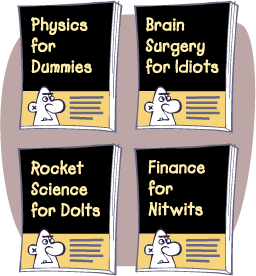
A little knowledge is a dangerous thing.
There’s nothing wrong with knowledge, it’s the little part that causes trouble. Charles Darwin put it this way, “Ignorance more frequently begets confidence than does knowledge.” You may suspect there is a kernel of truth in the old saw about a little knowledge. Suspect no more, researchers David Dunning and Justin Kruger won a Nobel Prize for proving it’s true.
They call it the Dunning-Kruger Effect, a cognitive bias where lesser skilled people mistakenly rate their ability unrealistically high. Basically because they don’t know enough to recognize their mistakes. Ironically, gaining competence actually weakens confidence as people start realizing how much more they don’t know. Here’s my version of Dunning and Kruger’s graph with added notations:
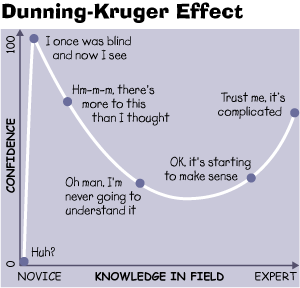
Having conquered one old adage, perhaps misters Dunning and Kruger are now tackling some other old chestnut. Maybe, Time is money. This may have them stymied. Physicists don’t agree on the definition of time, to some time isn’t even real. Then again, economists all concur on just about nothing.
Filed 1/11/15
Trivia In Black and White
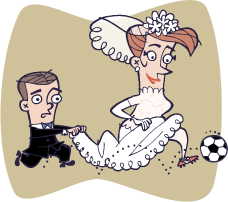
When we think of the iconic soccer ball, we think of white hexagon and black pentagon panels. A ball as if designed by Buckminster Fuller whose geodesic domes used the same pattern. We might be tempted to call it a buckyball (buckminsterfullerene), but that’s actually something else.
Soccer balls weren’t always made this way. For a hundred years or so the balls were made of 18 strips of leather in a pattern like a volleyball. This revolutionary and now famous black and white ball was invented by Adidas for the 1970 World Cup in Mexico. This iconic ball had a name, the Telstar.
For readers too young to remember the 1960s, Telstar was the first telecommunications satellite. If you know what it looked like you would easily see why the ball was named after it. By the time Mexico hosted the World Cup again in 1986, the Telstar was out of official use. The ball that time was called the Azteca.
It’s claimed the Telstar design helped players follow the flight and spin of the ball easier. Whether that’s true or just marketing by Adidas I’m not so sure. At any rate, the ball was a smashing success. Even though it was used only for a couple decades it’s still what we think of when we think of a soccer ball. Sports websites use it as an icon to mean soccer. You can’t get more iconic than that.
Queen Victoria is well known for wearing mourning black from the death of her beloved husband, Prince Albert, until her own death years later. Less well known is on the much happier event of her marriage she began the tradition of brides wearing white.
Before then brides wore wedding gowns of no color in particular. Most folks, who couldn’t afford to buy a dress just to be married in, likely wore their Sunday best, whatever the color. The rich and famous often set the fashion and no-one was more rich and famous than Queen Victoria in her day. The fashion of brides in white took hold, spread, and hasn’t receded yet.
Filed 1/5/15





